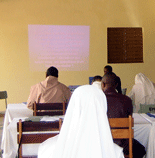West African Benedictines to adapt Eco Handbook
February 14, 2006:
Heads of Benedictine monasteries in West Africa last month agreed to adapt and use an Eco Handbook, created by ARC for use in other regions.
The meeting, in Keur Moussa, Senegal included representatives of monasteries in Senegal, Togo, Guinea, Guinea Bissau, Burkina Faso, Ivory Coast and Benin and was also attended by Paola Triolo, ARC's project manager for West Africa.
"The agreements and discussions opened the door to many exciting future environmental projects in the region," Ms Triolo said.
 |
 |
 |
Benedictine monks and nuns at Keur Moussa monastery |
ARC has been working in collaboration with the Benedictines’ Alliance Inter Monastere (AIM), to set up a model project with Katibunga Monastery in Zambia, looking at animal farming, land management and forestry. It is an extremely remote community, and so the activities of the Benedictine community have a substantial impact on the local economy – affecting the agricultural system (veering towards the organic and away from heavy chemicals), and improving the health and schooling of the 2500 local families living in local villages.
ARC presented an environmental handbook and audit kit that it has developed with the Benedictine Sisters in Lake Eirie, Canada, for use in South American communities. ARC hopes to help the Benedictines in West Africa to adapt it for an African audience, making it more compact, translating it into French and adding African examples.
 |
| “Orare est laborare, laborare est orare” - to pray is to work, to work is to pray. St Benedict, 6th Century. |
|
 |
 |
The West African Benedictines have already commissioned a questionnaire to find out what all the monasteries were doing and how. They had taken Senegal as an example and looked at the activities they were performing in comparison with what the local market does, asking the following underlying question.
Since Benedictine monasteries are engaged in a lot of different activities, meaning that their efforts are spread over a wide range of skills, is there a way of them concentrating on a smaller number of activities and being more effective, both socially and economically?
One of St Benedicts’s greatest sayings was: “Orare est laborare, laborare est orare” - to pray is to work, to work is to pray – and each monastery gave a presentation on what they thought it meant for Benedictines to work.
In future ARC hopes to develop working projects with the Benedictines linked to environmental auditing, water and agro-forestry issues, working with the World Bank offices in each country, and using the experience gained from those projects to develop a basic common rationale that can be used in other monastic communities throughout Africa.
Link here, for a story from Katibunga Monastery.
Link here, for a story of the relationship between ARC and the Benedictine communities.
|

